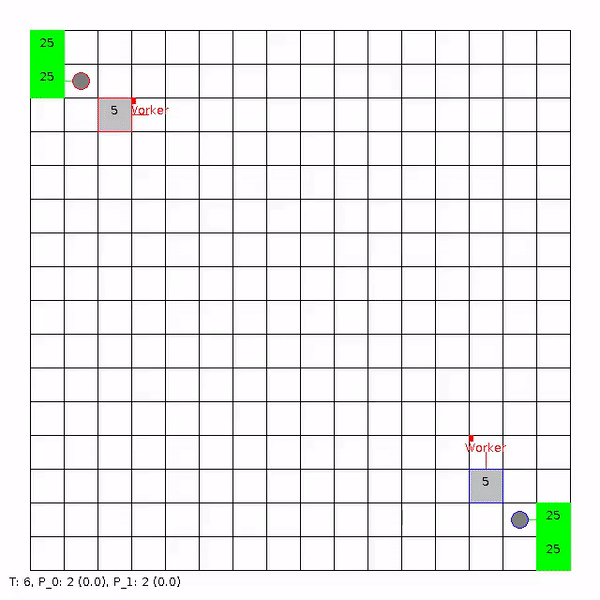This repo contains the source code for the gym wrapper of μRTS authored by Santiago Ontañón.
Prerequisites:
- Python 3.8+
- Poetry
- Java 8.0+
- FFmpeg (for video recording utilities)
$ git clone --recursive https://github.com/vwxyzjn/gym-microrts.git && \
cd gym-microrts
poetry install
# build microrts
bash build.sh &> build.log
python hello_world.pyTo train an agent, run the following
cd experiments
python ppo_gridnet.py \
--total-timesteps 100000000 \
--capture-video \
--seed 1For running a partial observable example, tune the partial_obs argument.
cd experiments
python ppo_gridnet.py \
--partial-obs \
--capture-video \
--seed 1Before diving into the code, we highly recommend reading the preprint of our paper: Gym-μRTS: Toward Affordable Deep Reinforcement Learning Research in Real-time Strategy Games
Note that the experiments in the technical paper above are done with gym_microrts==0.3.2. As we move forward beyond v0.4.x, we are planing to deprecate UAS despite its better performance in the paper. This is because UAS has more complex implementation and makes it really difficult to incorporate selfplay or imitation learning in the future.
Here is a description of Gym-μRTS's observation and action space:
-
Observation Space. (
Box(0, 1, (h, w, 27), int32)) Given a map of sizeh x w, the observation is a tensor of shape(h, w, n_f), wheren_fis a number of feature planes that have binary values. The observation space used in this paper uses 27 feature planes as shown in the following table. A feature plane can be thought of as a concatenation of multiple one-hot encoded features. As an example, if there is a worker with hit points equal to 1, not carrying any resources, owner being Player 1, and currently not executing any actions, then the one-hot encoding features will look like the following:[0,1,0,0,0], [1,0,0,0,0], [1,0,0], [0,0,0,0,1,0,0,0], [1,0,0,0,0,0]The 27 values of each feature plane for the position in the map of such worker will thus be:
[0,1,0,0,0,1,0,0,0,0,1,0,0,0,0,0,0,1,0,0,0,1,0,0,0,0,0] -
Partial Observation Space. (
Box(0, 1, (h, w, 29), int32)) Given a map of sizeh x w, the observation is a tensor of shape(h, w, n_f), wheren_fis a number of feature planes that have binary values. The observation space for partial observability uses 29 feature planes as shown in the following table. A feature plane can be thought of as a concatenation of multiple one-hot encoded features. As an example, if there is a worker with hit points equal to 1, not carrying any resources, owner being Player 1, currently not executing any actions, and not visible to the opponent, then the one-hot encoding features will look like the following:[0,1,0,0,0], [1,0,0,0,0], [1,0,0], [0,0,0,0,1,0,0,0], [1,0,0,0,0,0], [1,0]The 29 values of each feature plane for the position in the map of such worker will thus be:
[0,1,0,0,0,1,0,0,0,0,1,0,0,0,0,0,0,1,0,0,0,1,0,0,0,0,0,1,0] -
Action Space. (
MultiDiscrete(concat(h * w * [[6 4 4 4 4 7 a_r]]))) Given a map of sizeh x wand the maximum attack rangea_r=7, the action is an (7hw)-dimensional vector of discrete values as specified in the following table. The first 7 component of the action vector represents the actions issued to the unit atx=0,y=0, and the second 7 component represents actions issued to the unit atx=0,y=1, etc. In these 7 components, the first component is the action type, and the rest of components represent the different parameters different action types can take. Depending on which action type is selected, the game engine will use the corresponding parameters to execute the action. As an example, if the RL agent issues a move south action to the worker at$x=0, y=1$ in a 2x2 map, the action will be encoded in the following way:concat([0,0,0,0,0,0,0], [1,2,0,0,0,0,0], [0,0,0,0,0,0,0], [0,0,0,0,0,0,0]]=[0,0,0,0,0,0,0,1,2,0,0,0,0,0,0,0,0,0,0,0,0,0,0,0,0,0,0,0]
You can evaluate trained agents against a built-in bot:
cd experiments
python ppo_gridnet_eval.py \
--agent-model-path gym-microrts-static-files/agent_sota.pt \
--ai coacAIAlternatively, you can evaluate the trained RL bots against themselves
cd experiments
python ppo_gridnet_eval.py \
--agent-model-path gym-microrts-static-files/agent_sota.pt \
--agent2-model-path gym-microrts-static-files/agent_sota.ptThis repository already contains a preset Trueskill database in experiments/league.db. To evaluate a new AI, try running the following command, which will iteratively find good matches for agent.pt until the engine is confident agent.pt's Trueskill (by having the agent's Trueskill sigma below --highest-sigma 1.4).
cd experiments
python league.py --evals gym-microrts-static-files/agent_sota.pt --highest-sigma 1.4 --update-db FalseTo recreate the preset Trueskill database, start a round-robin Trueskill evaluation among built-in AIs by removing the database in experiments/league.db.
cd experiments
rm league.csv league.db
python league.py --evals randomBiasedAI workerRushAI lightRushAI coacAIThe training script allows you to train the agents with more than one maps and evaluate with more than one maps. Try executing:
cd experiments
python ppo_gridnet.py \
--train-maps maps/16x16/basesWorkers16x16B.xml maps/16x16/basesWorkers16x16C.xml maps/16x16/basesWorkers16x16D.xml maps/16x16/basesWorkers16x16E.xml maps/16x16/basesWorkers16x16F.xml \
--eval-maps maps/16x16/basesWorkers16x16B.xml maps/16x16/basesWorkers16x16C.xml maps/16x16/basesWorkers16x16D.xml maps/16x16/basesWorkers16x16E.xml maps/16x16/basesWorkers16x16F.xml
where --train-maps allows you to specify the training maps and --eval-maps the evaluation maps. --train-maps and --eval-maps do not have to match (so you can evaluate on maps the agent has never trained on before).
[ ] Rendering does not exactly work in macos. See jpype-project/jpype#906
- CoG 2021: Gym-μRTS: Toward Affordable Deep Reinforcement Learning Research in Real-time Strategy Games
- AAAI RLG 2021: Generalization in Deep Reinforcement Learning with Real-time Strategy Games,
- AIIDE 2020 Strategy Games Workshop: Action Guidance: Getting the Best of Training Agents with Sparse Rewards and Shaped Rewards,
- AIIDE 2019 Strategy Games Workshop: Comparing Observation and Action Representations for Deep Reinforcement Learning in MicroRTS,
We wrapped our Gym-µRTS simulator into a PettingZoo environment, which is defined in gym_microrts/pettingzoo_api.py. An example usage of the Gym-µRTS PettingZoo environment can be found in hello_world_pettingzoo.py.
To cite the Gym-µRTS simulator:
@inproceedings{huang2021gym,
author={Huang, Shengyi and Ontañón, Santiago and Bamford, Chris and Grela, Lukasz},
booktitle={2021 IEEE Conference on Games (CoG)},
title={Gym-µRTS: Toward Affordable Full Game Real-time Strategy Games Research with Deep Reinforcement Learning},
year={2021},
volume={},
number={},
pages={1-8},
doi={10.1109/CoG52621.2021.9619076}}To cite the invalid action masking technique used in our training script:
@inproceedings{huang2020closer,
title={A Closer Look at Invalid Action Masking in Policy Gradient Algorithms},
volume={35},url={https://journals.flvc.org/FLAIRS/article/view/130584},
DOI={10.32473/flairs.v35i.130584},
journal={The International FLAIRS Conference Proceedings},
author={Huang, Shengyi and Ontañón, Santiago},
year={2022},
month={May}
}

